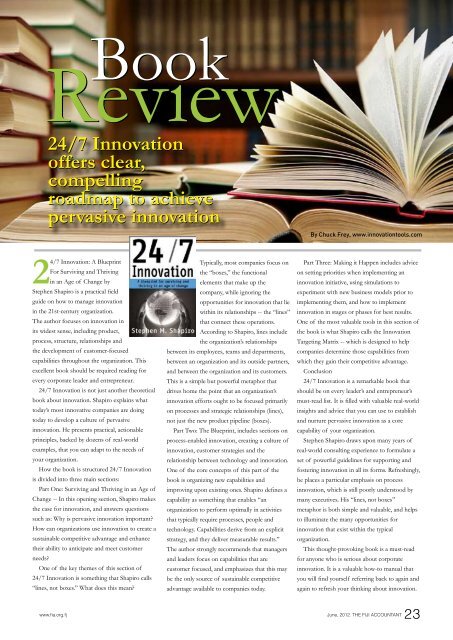Download - Fiji Institute of Accountants
Download - Fiji Institute of Accountants
Download - Fiji Institute of Accountants
You also want an ePaper? Increase the reach of your titles
YUMPU automatically turns print PDFs into web optimized ePapers that Google loves.
24/7 Innovation: A Blueprint<br />
For Surviving and Thriving<br />
in an Age <strong>of</strong> Change by<br />
Stephen Shapiro is a practical field<br />
guide on how to manage innovation<br />
in the 21st-century organization.<br />
The author focuses on innovation in<br />
its widest sense, including product,<br />
process, structure, relationships and<br />
the development <strong>of</strong> customer-focused<br />
capabilities throughout the organization. This<br />
excellent book should be required reading for<br />
every corporate leader and entrepreneur.<br />
24/7 Innovation is not just another theoretical<br />
book about innovation. Shapiro explains what<br />
today’s most innovative companies are doing<br />
today to develop a culture <strong>of</strong> pervasive<br />
innovation. He presents practical, actionable<br />
principles, backed by dozens <strong>of</strong> real-world<br />
examples, that you can adapt to the needs <strong>of</strong><br />
your organization.<br />
How the book is structured 24/7 Innovation<br />
is divided into three main sections:<br />
Part One: Surviving and Thriving in an Age <strong>of</strong><br />
Change -- In this opening section, Shapiro makes<br />
the case for innovation, and answers questions<br />
such as: Why is pervasive innovation important?<br />
How can organizations use innovation to create a<br />
sustainable competitive advantage and enhance<br />
their ability to anticipate and meet customer<br />
needs?<br />
One <strong>of</strong> the key themes <strong>of</strong> this section <strong>of</strong><br />
24/7 Innovation is something that Shapiro calls<br />
“lines, not boxes.” What does this mean?<br />
Typically, most companies focus on<br />
the “boxes,” the functional<br />
elements that make up the<br />
company, while ignoring the<br />
opportunities for innovation that lie<br />
within its relationships -- the “lines”<br />
that connect these operations.<br />
According to Shapiro, lines include<br />
the organization’s relationships<br />
between its employees, teams and departments,<br />
between an organization and its outside partners,<br />
and between the organization and its customers.<br />
This is a simple but powerful metaphor that<br />
drives home the point that an organization’s<br />
innovation efforts ought to be focused primarily<br />
on processes and strategic relationships (lines),<br />
not just the new product pipeline (boxes).<br />
Part Two: The Blueprint, includes sections on<br />
process-enabled innovation, creating a culture <strong>of</strong><br />
innovation, customer strategies and the<br />
relationship between technology and innovation.<br />
One <strong>of</strong> the core concepts <strong>of</strong> this part <strong>of</strong> the<br />
book is organizing new capabilities and<br />
improving upon existing ones. Shapiro defines a<br />
capability as something that enables “an<br />
organization to perform optimally in activities<br />
that typically require processes, people and<br />
technology. Capabilities derive from an explicit<br />
strategy, and they deliver measurable results.”<br />
The author strongly recommends that managers<br />
and leaders focus on capabilities that are<br />
customer focused, and emphasizes that this may<br />
be the only source <strong>of</strong> sustainable competitive<br />
advantage available to companies today.<br />
By Chuck Frey, www.innovationtools.com<br />
Part Three: Making it Happen includes advice<br />
on setting priorities when implementing an<br />
innovation initiative, using simulations to<br />
experiment with new business models prior to<br />
implementing them, and how to implement<br />
innovation in stages or phases for best results.<br />
One <strong>of</strong> the most valuable tools in this section <strong>of</strong><br />
the book is what Shapiro calls the Innovation<br />
Targeting Matrix -- which is designed to help<br />
companies determine those capabilities from<br />
which they gain their competitive advantage.<br />
Conclusion<br />
24/7 Innovation is a remarkable book that<br />
should be on every leader’s and entrepreneur’s<br />
must-read list. It is filled with valuable real-world<br />
insights and advice that you can use to establish<br />
and nurture pervasive innovation as a core<br />
capability <strong>of</strong> your organization.<br />
Stephen Shapiro draws upon many years <strong>of</strong><br />
real-world consulting experience to formulate a<br />
set <strong>of</strong> powerful guidelines for supporting and<br />
fostering innovation in all its forms. Refreshingly,<br />
he places a particular emphasis on process<br />
innovation, which is still poorly understood by<br />
many executives. His “lines, not boxes”<br />
metaphor is both simple and valuable, and helps<br />
to illuminate the many opportunities for<br />
innovation that exist within the typical<br />
organization.<br />
This thought-provoking book is a must-read<br />
for anyone who is serious about corporate<br />
innovation. It is a valuable how-to manual that<br />
you will find yourself referring back to again and<br />
again to refresh your thinking about innovation.<br />
www.fia.org.fj June, 2012. The FiJi AccounTAnT 23
















